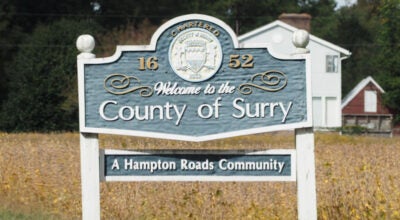Rotary clubs building ‘book barn’ at Mill Swamp Indian Horses
Published 3:44 pm Monday, December 4, 2023
Steve Edwards’ Mill Swamp Indian Horses program will soon have its own library of horsemanship materials courtesy of the Smithfield and Suffolk Rotary clubs.
For two months, volunteers from the two clubs have been working to build what Edwards calls the “book barn” from the ground up.
Sixteen years ago, Edwards adopted his first Corolla mustangs, an endangered breed that’s lived wild in North Carolina’s Outer Banks since the 16th century. For the past 12 of those years, he and a group of volunteers have taken what’s now known as the Mill Swamp Indian Horses preservation program in a new, human-focused direction that uses horsemanship to teach caregivers how to recognize and respond to trauma victims, and help the victims themselves rebuild their lives.
Edwards, who frequently encounters trauma victims in his day job as a prosecutor, has amassed a collection of books and other educational materials on livestock conservation and microbial farming, which are presently scattered throughout the nearly 60-acre Gwaltney Family Farm. The farm dates to 1635 when the original Gwaltney family came to Isle of Wight County, and has been in Edwards’ family for five generations.
“This is going to have everything centralized beautifully,” Edwards said.
Chris Torre, a retired real estate developer and contractor whom the Smithfield Rotary club named chairman of its construction committee, drew the plans for the building himself. He’s been working at the site almost every day since early October. On Oct. 2, he and a team of volunteers had finished setting the concrete forms for the barn’s slab foundation.
Now, the building’s wooden exterior is nearly complete and it sports solar panels on the roof to power a low-voltage lighting system another Rotary Club member designed.
“It will be the educational opposite of a self storage facility where things are placed to be put away and forgotten,” Edwards said. “It will be a place for program participants to access information on everything that we do, including horse training, livestock preservation and care, soil and water conservation and wildlife habitat creation. This project will be a tremendous asset to our overall agricultural program.
A full-sized horse statue salvaged from Hardy Elementary will be repainted to resemble “Croatoan,” the first Corolla mustang Edwards brought to his farm, and re-erected outside the barn.
A group of homeschooled students enrolled in Mill Swamp’s youth program salvaged the horse in September, which had stood outside the now-demolished circa-1961 school since 2002.
“We have some very artistic people in this program,” Edwards said.
A new horse statue now stands outside the two-story replacement Hardy that opened its doors in September.











